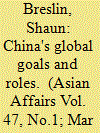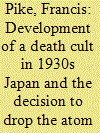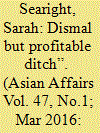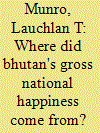| Srl | Item |
| 1 |
ID:
144204


|
|
|
|
|
| Summary/Abstract |
Whilst there is a general acceptance amongst Chinese analysts that the country's global power has really increased (and for very good reasons), how best to use this power to generate real change in the global order remains a subject of considerable debate. The nature of that international order itself is a key determinant of what China can do. On one level the rise of new powers is leading to a depolarised order with fluid and changing alliances that create possibilities for China to build partnerships for change. But on another level, the residual power of the US creates clear limits on what can be done. This creates a rather unique set of circumstances where a partially dissatisfied rising power has to try to find ways to responsibly change (but not fracture) the existing system as self-perceived No.2, with the No.1 rather reluctant to accept the No.2's agenda.
|
|
|
|
|
|
|
|
|
|
|
|
|
|
|
|
| 2 |
ID:
144202


|
|
|
|
|
| Summary/Abstract |
In the 1930s Japan developed a death cult which had a profound effect on the conduct of the Japanese armed forces in the Pacific War, 1941–1945. As a result of government directed propaganda campaign after the overthrow of the Shogunate in 1868, the ruling military cliques restored an Imperial system of government which placed Emperor Meiji as the Godhead central to the constitution and spiritual life of the Japanese nation. A bastardised Bushido cult emerged. It combined with a Social-Darwinist belief in Japan's manifest destiny to dominate Asia. The result was a murderous brutality that became synonymous with Japanese treatment of prisoners of war and conquered civilians. Japan's death cult was equally driven by a belief in self-sacrifice characterised by suicidal Banzai charges and kamikaze attacks. The result was kill ratios of Japanese troops in the Pacific War that were unique in the history of warfare. Even Japanese civilians were expected to sacrifice their lives in equal measure in the defence of the homeland. It was for this reason that American war planners came to the shocking estimate that as many as 900,000 Allied troops could die in the conquest of mainland Japan – Operation DOWNFALL. Contrary to the view of numbers of revisionist historians in the post-war period, who have variously argued that the atom bombs were used to prevent Soviet entry into the war against Japan, Francis Pike, author of Hirohito's War, The Pacific War, 1941 – 1945 [Bloomsbury 2015] reaffirms that the nuclear weapon was used for one purpose alone – to bring the war to a speedy end and to save the lives of American troops.
|
|
|
|
|
|
|
|
|
|
|
|
|
|
|
|
| 3 |
ID:
144206


|
|
|
|
|
| Summary/Abstract |
This article traces the history of the Suez Canal since its origins in the 19th century to the present-day. It gives an outline not only of the antecedents of the Canal, but also looks at the August 2015 widening and deepening of the Canal with its effects of the Egyptian economy and international commerce.
|
|
|
|
|
|
|
|
|
|
|
|
|
|
|
|
| 4 |
ID:
144207


|
|
|
|
|
| Summary/Abstract |
This article traces the development of the Sino-Indian Boundary problems from their origins during the “Great Game” period during the British Empire in India to the present day. The article looks at both the Western and Eastern Sectors, and traces the development of the various putative frontiers (the Johnson-Ardagh/ Macartney-MacDonald Lines and the McMahon Line respectively). The article looks at recent tensions which have arisen over the frontier areas, as well as the prolonged but unsuccessful attempts to solve the disputes, and considers what moves might be necessary to bring a final resolution of the problems.
|
|
|
|
|
|
|
|
|
|
|
|
|
|
|
|
| 5 |
ID:
144203


|
|
|
|
|
| Summary/Abstract |
Recent literature has aimed to “deconstruct” the notion of a “Sino-Indian rivalry” in Myanmar. The argument is that China's leverage in Myanmar far outweighs India's, and that the Tatmadaw nevertheless prevents either country's manipulation of Myanmar. In contrast this article argues that the idea of a “Sino-Indian Great Game” still marks the Indian debate, thinking and policy on Myanmar. China's continued rise will remain a main driver behind India's Myanmar policy, and Myanmar will remain geostrategic relevant to India.
The article describes the historical legacy of India's relationship with Myanmar, discusses the role of China in Indian Myanmar policies, and examines the effects of Myanmar's democratization process. While the Myanmar playing field has changed, Indian perceptions of a “Sino-Indian Great Game” are lasting.
|
|
|
|
|
|
|
|
|
|
|
|
|
|
|
|
| 6 |
ID:
144205


|
|
|
|
|
| Summary/Abstract |
The Kingdom of Bhutan has attracted international attention for adopting “Gross National Happiness” (GNH) as its national development policy. The central notion is that gross national happiness is more important than gross national product; the four pillars of GNH are sustainable economic development, good governance, preservation of the natural environment and preservation of the national culture. This paper traces the historical origins of the concept of Gross National Happiness and finds that GNH is newer than the literature and the propaganda usually suggest. Close study of GNH's origins and salience over several decades reveals evidence of the invention of a tradition, in Hobsbawm and Ranger's terms [Eric Hobsbawm and Terence Ranger (Eds.), The Invention of Tradition. Cambridge: CUP, 1983]. The meteoric rise over the last 15 years of GNH as Bhutan's official ideology is a key part of the Bhutanese state's efforts at nation building in the context of rapid and disruptive social and economic change in a highly plural society.
|
|
|
|
|
|
|
|
|
|
|
|
|
|
|
|